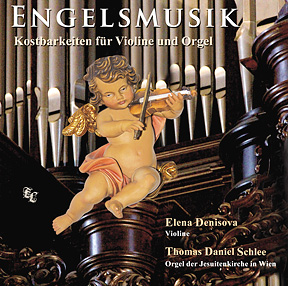

As challenging as the combin-tion of the infinitely variable sound of the violin with the predictable timbres of the organ may seem, it is precisely this innate contrast that underscores the lyrical quality of the bowed string instrument. The violin suddenly becomes an Orphic producer of tones, a source of never-ending song without words.
The melodic lines of the two beguiling works by Sigfrid Karg-Elert (1877-1933) seamlessly rise and fall as if in one long breath. Even as the structures of these works remain coherent and distinct they are free and in a state of constant forward motion. The harmonies are at once diatonically chaste but imbued with chromatic density (Max Reger was one of the composer's mentors) and impressionistic feeling - as reflected in the remarkable fluidity of chords.
The accessibility of this music combined with the incessant transformations are the essence of its expressive elements. "Sanctus" and "Pastorale" seem to be scenes - albeit of completely different content - in which utopia and reality confront each other.
Franz Liszt (1811-1886) composed his "Hungarian Coronation Mass" for the coronation of Emperor Franz Josef as the apostolic King of Hungary, which took place on June 8, 1867 in Buda(pest). He probably created the adaptations of the offertory and the benediction for violin and organ four years later. The structure of the composition itself is Spartan, emphasizing the smallest variations or nuances while creating an intense atmosphere of intimacy. At times the melodies show folkloric Hungarian influence while stirring surges are reflective of the original version for orchestra. What characterizes the work in general, however, is its exquisite simplicity and transparency.
We also find an emphasis on the "singing violin" on the present CD in two attrac-tive works stemming from the great French organ tradition of the 20th century:
Jean Langlais (1907-1991) was one of the most important and prolific organ composers in France and, as titular organist on the famous Cavaillé Coll organ of the Parisian Basilica Sainte-Clotilde, was the successor to César Franck and Charles Tournemire. With his "Cinq Pièces" (1974) he created a charming arrangement of his "Cinq Mélodies" for voice and piano, which had been composed 20 years earlier based on words of the renaissance poets Pierre de Ronsard and Jean Antoine de Baïf. The stanza progression of the original is retained, although with each successive verse the violin varies the melodic contours. What is remarkable about these pieces is that the stylistic refinement for which Langlais is so well known dominates in spite of the overall simplicity of the work. Art music and folk influences (albeit somewhat artificial) seem to blend perfectly.
Joseph Reveyron (1917-2005), who is regrettably less well known, was the or-ganist of the Archbishopric Saint-Jean in Lyon. He leaves behind a diverse œuvre with a significant portion of organ music, vocal works and numerous compositions for solo instrument and organ, among which the original works on the present recording are found. The "Verset" of 1955 could be considered to be an equivalent in tones of a capitulum, a short excerpt from the Bible that eventually merges into an extended meditation. Reveyron's characteristic, free modal musical idiom is even more evident, sometimes quite intensely, in the rendition of the fourth "Psalm". As if in a small tone poem there are two starkly contrasting elements in this remarkable composition that lead only in the final measures to carefree tranquility: the violin with its questions and entreaties and the organ as a manifestation of divine providence.
Three short organ interludes serve as intermezzi in the program of the works presented here: the poetic "Chant des Bergers," one of the earliest compositions of Langlais (1929); the "Jubilatoire" by Reveyron based on a stylistically subtly nuanced chorale prelude discovered fortuitously by a grandchild of the composer; and a "Nocturne" of Germaine Tailleferre (1977 transcription of a sere-nade for woodwinds) that conveys - primarily on the white keys - a touching, impressionistically elegant fascination.
The Marian pieces of Austrian composers committed to a musical Jugendstil are exclusively original vocal works. The "Ave Maria" by Franz Schreker (1878-1934) who later achieved fame as an opera composer was conceived in 1909 as a gift for the patron of the arts, princess Alexandrine of Windischgraetz. In 1911 Joseph Marx (1882-1964) arranged a work composed two years previously, a "song of Mary," based on a text by Novalis for voice and organ. The work is characterized by strains of elaborate and sumptuous harmonies of the kind produced between the period between the World Wars that were to make Marx one of the most prominent composers of his generation, famous for his vocal and symphonic creations.
Complex musical creations often succeed through the unexpected introduction of a completely new theme very near the end of the composition (as in the final duet of Richard Strauss' "Rosenkavalier."). This is the manner in which the mighty chaconne by Tommaso Antonio Vitali (1663-1745) concludes a program on this CD that is otherwise defined by subtle nuances issuing from sparse and unpretentious forms. First published in the 19th century by Ferdinand David in his "School of Virtuoso Violin Performance" the piece is an extraordinary work that showcases all manner of performance techniques and expressive potential of the solo instrument. Even after exhaustive research it is not clear that Vitali actually wrote the piece. The harmonic development of the piece is remarkable: It encompasses enharmonic tetrachords and even an ascending five-bar(!) counter figure in four stages to contrast with the classic descending chaconne bass. This accords the violin virtuoso added impetus for clearly Romantic embellishments that seem to have firmly established themselves up to the present day. One is left imagining a stylistic 19th century game of deception. The ballad of the sirens resounds through time …
© Thomas Daniel Schle
